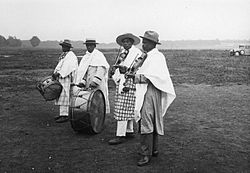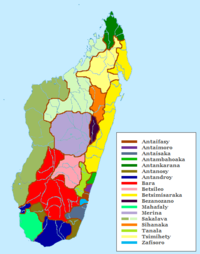- Merina people
-
Not to be confused with the Mirena intrauterine system.
Merina Total population 5 million Regions with significant populations Madagascar Languages Religion Christianity, Animism
Related ethnic groups The Merina are an ethnic group from Madagascar.[1] The Merina are concentrated in the Highlands and speak the official dialect of the Malagasy language, which is a branch of the Malayo-Polynesian language group derived from the Barito languages, spoken in southern Borneo. Their ancestors, the Austronesians, migrated from Borneo in the Malay archipelago around 1 BC. Today, the Austronesian features of the Merina are still quite visible. The Merina cultivate rice, cassava, potatoes, onions, and other crops and raise cattle and pigs. They constitute a large proportion of the educated middle-class and intellectual elite of Madagascar, serving as businessmen, technicians, managers, and government officials.
Beginning in the late 18th century, Merina sovereigns extended political domination over the rest of the island, ultimately uniting it under their rule. In 1895–96 the French colonized Madagascar and abolished the Merina monarchy by force in 1897.
Contents
The Merina Kingdom
Main article: Merina KingdomOral history traces the emergence of a united kingdom in the central highlands of Madagascar – a region called Imerina – back to early 16th century king Andriamanelo. By 1824, sovereigns in his line had conquered nearly all of Madagascar, particularly through the military strategy and ambitious political policies of Andrianampoinimerina (circa 1785–1810) and his son Radama I (1792–1828). The kingdom's contact with British and later French powers helped modernize the state, allowing its very capable leaders to build schools and an impressive modern army. But the peace and stability of the Merina kingdom would come to an end with the first Franco-Hova War. At the war’s end, Madagascar ceded Antsiranana (Diégo Suarez) on the northern coast to France and paid 560,000 gold francs to the heirs of Joseph-François Lambert, a Frenchman who had been promised lucrative trade privileges under King Radama II that had later been revoked. In Europe, meanwhile, diplomats partitioning the African continent worked out an agreement whereby Britain, in order to obtain the Sultanate of Zanzibar, ceded its rights over Heligoland to Germany and renounced all claims to Madagascar in favor of France. The agreement spelled doom for the independence of Madagascar.
In 1895, a French flying-column landed in Mahajanga (Majunga) and marched by way of the Betsiboka River to the capital, Antananarivo, taking the city’s defenders by surprise. They had expected an attack from the much closer east coast. Twenty French soldiers died fighting and 6,000 died of malaria and other diseases before the second Franco-Hova War ended. In 1896 the French Parliament voted to annex Madagascar. The 103-year-old Merina monarchy ended with Queen Ranavalona III and her Prime Minister, Rainilaiarivony sent to exile in Algeria.
Caste system
Main article: AndrianaAmong all the Malagasy ethnicities, the Merina historically have one of the most stratified caste systems. In general they are divided into three classes: the Andriana (nobles), the Hova (freemen), and the Andevo (slaves). Each class is then hierarchically divided into subclasses.
The Andriana are divided into seven subclasses, from the highest ranking to the lowest as follows:
- Zanakandriana: A small, elite sub-group of the Zazamarolahy from which a sovereign's successor was selected.
- Zazamarolahy (or Marolahy): Direct descendants of the sovereign.
- Andriamasinavalona: Noble descendants of the four sons of King Andriamasinavalona who were excluded from ruling one of the four sub-divisions of Imerina that had been made the fiefs of his four preferred sons.
- Andriantompokondrindra (or Zanatompo): Descendents of King Andriantompokondrindra, the oldest son of King Ralambo, who according to one popular legend was passed over for the kingship in favor of his brother Andrianjaka (reportedly due to a game of fanorona).
- Andrianamboninolona ("Princes Above the People") or Zanakambony ("Sons Above"): Descendents of those who accompanied King Andrianjaka on his conquest of Antananarivo
- Andriandranando (or Zafinadriandranando)
- Zanadralambo
Culture
Cuisine
The cuisine of the Merina is so heavily dominated by rice that the term for eating a meal is simply "to eat rice". This staple of the diet is so central to the Merina that it is considered to be masina, or holy, and a common Merina belief holds that the eating of rice is the key to moral behaviour, and the French who occupied Merina lands were often looked down upon for eating bread over rice.[2] Beef also plays a large part in the Merina diet, and according to Merina oral history, it was a servant of King Ralambo who discovered that cows were edible and shared this knowledge with the king, who in turn informed the rest of his kingdom.[2]
Traditional Beliefs and Practices
The Vazimba feature prominently in Merina oral history and popular imagination. It has been speculated that the Vazimba were the original population of Madagascar, descended from Southeast Asian seafarers who may have had pygmy physical characteristics. Among some Malagasy, the Vazimba are not believed to be human at all, but rather a form of supernatural creature possessing magical powers (mahery).[2]
The Merina believe their land to be tanin'drazana (the land of the ancestors) and show reverence to their ancestors by burying them in family tombs typically located in the ancestral village of origin. Many believe that ancestors can intervene in events on Earth, for good or for ill, and this belief shapes the actions and thoughts of many Malagasy.[2] In the first seven years of their lives, boys are typically circumcised in a ritual wherein relatives request the blessings and protection of the ancestors.[2]
See also
References
- ^ Bradt, Hillary; Austin, Daniel (2007). Madagascar (9th ed.). Guilford, CT: The Globe Pequot Press Inc.. pp. 113–115. ISBN 1841621978. http://books.google.com/books?id=vyNVb2q0RisC&pg=PA23&dq=madagascar+ethnic+group&hl=en&ei=giDzTKbNKYLQsAOO15HLCw&sa=X&oi=book_result&ct=result&resnum=7&ved=0CEkQ6AEwBg#v=onepage&q=madagascar%20ethnic%20group&f=false.
- ^ a b c d e Bloch, M. (1985). Almost Eating the Ancestors. Man, 20(4), 631–646.
External links
Antaifasy · Antaimoro · Antaisaka · Antambahoaka · Antandroy · Antankarana · Antanosy · Bara · Betsileo · Betsimisaraka · Bezanozano · Karana (Indo-Pakistanis) · Mahafaly · Makoa · Merina · Mikea · Sakalava · Sihanaka · Sinoa (Chinese) · Tanala · Tsimihety · Vazaha (French, European) · Vazimba · Vezo · Zafimaniry · Zafisoro ·
Categories:- African ethnic group stubs
- Madagascar stubs
- Ethnic groups in Madagascar
Wikimedia Foundation. 2010.


